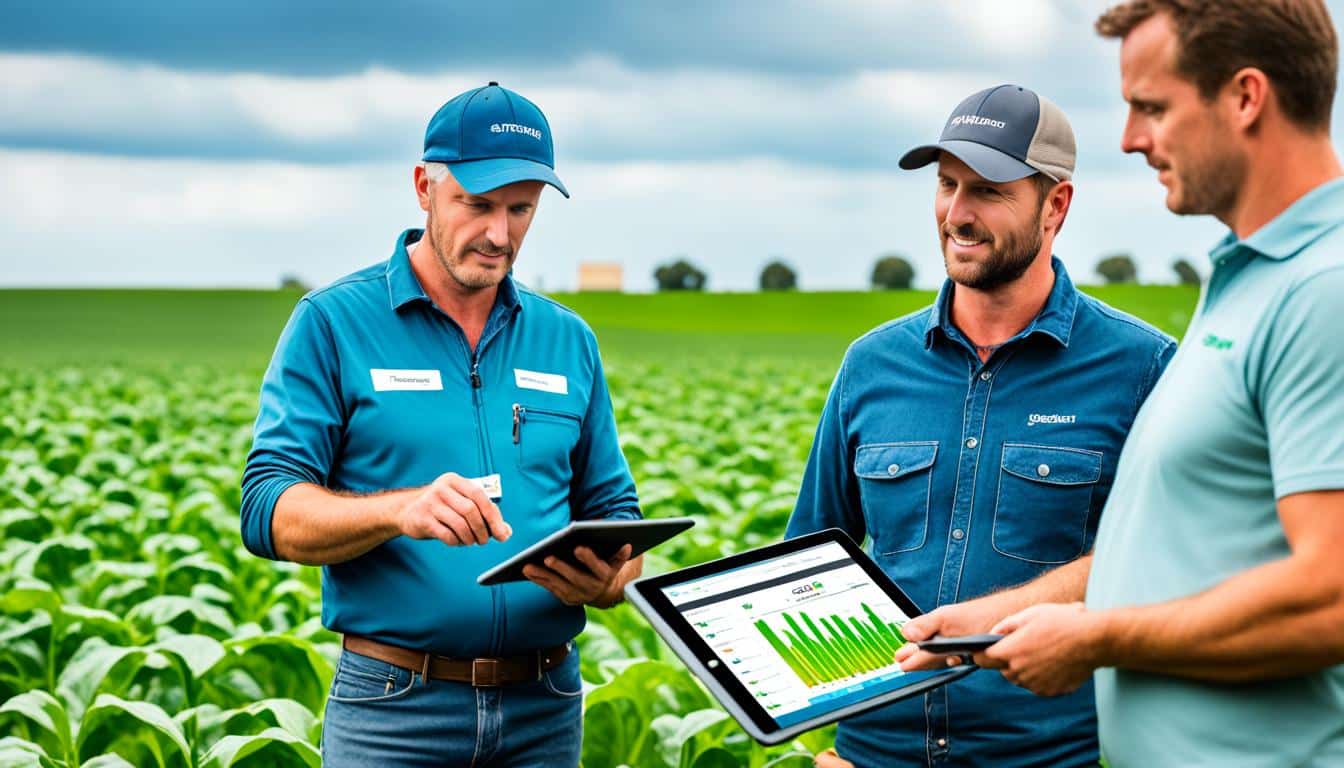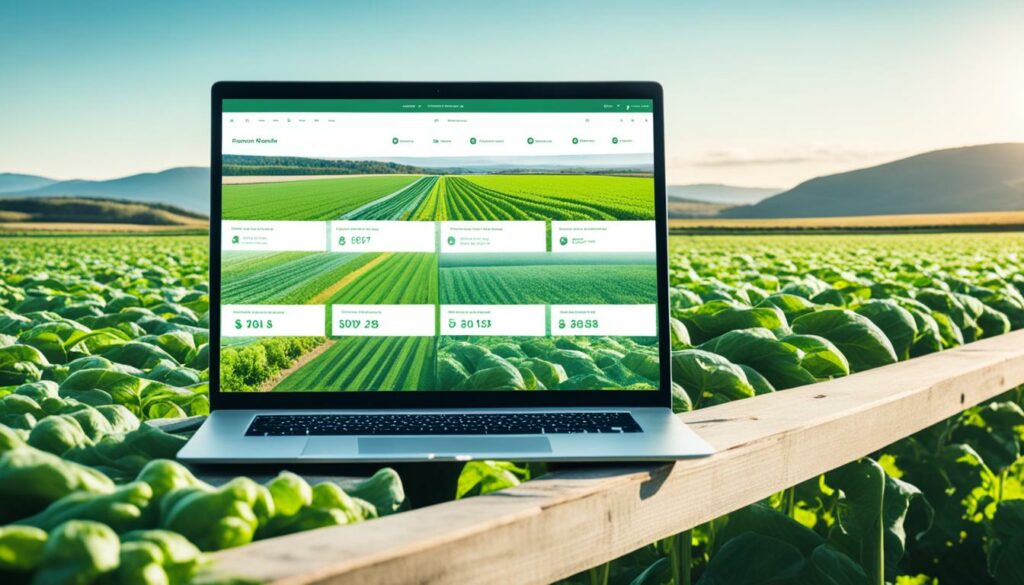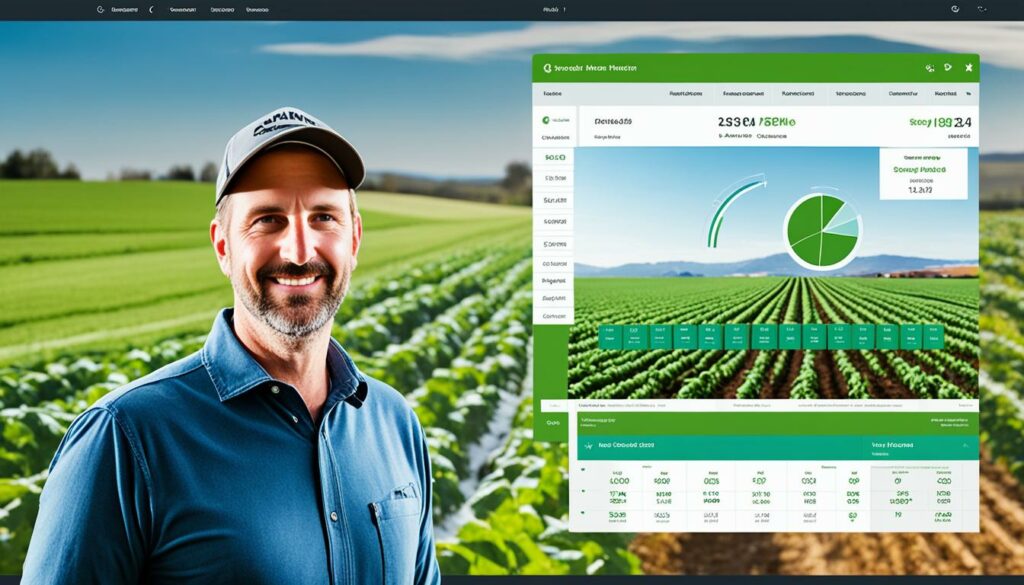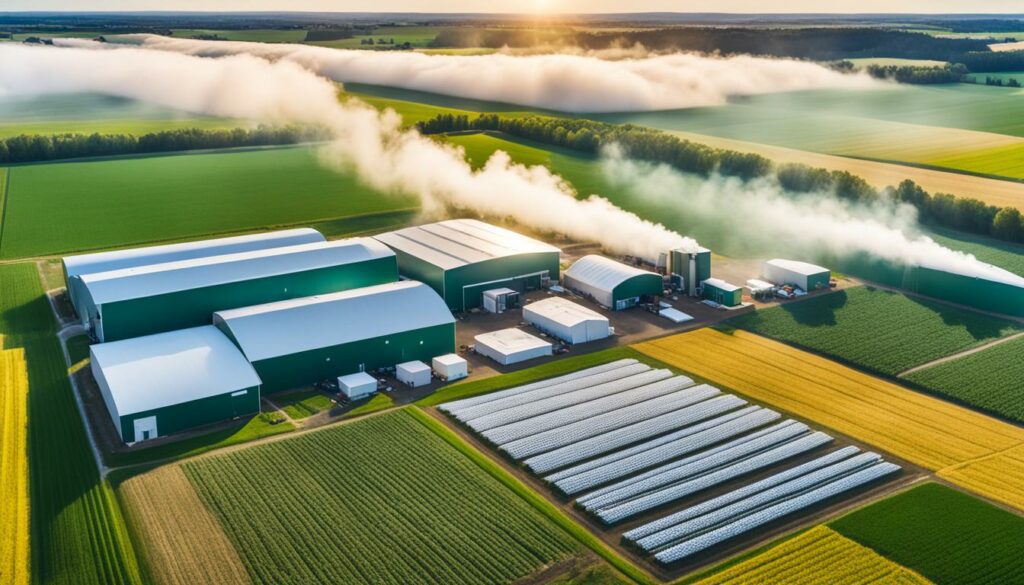Menu

Did you know, 90% of the leading farm software is now cloud-based? This large number shows a big change in how farmers work. Now, farms use digital tools more than the old-fashioned ones.
Cloud-based systems let farmers manage all their data in one place. This saves them time and can prevent mistakes. It gives them instant updates and makes talking to everyone working on the farm easier. This means less paper, better tracking of things, and sticking to the rules. Also, handling money is simpler and smarter, helping farms become more successful.
Another big plus of cloud farm software? It’s not too pricey. You don’t have to pay a lot upfront like with old-style software. This way, even small farms can afford it. Plus, you can use it on any gadget as long as you’ve got the internet. This is great for farms spread out over different areas or with special needs.
The history of farm management highlights human cleverness. It started with Charles Newbold’s iron plow in 1797. Now, we have high-tech farming equipment. This change shows how much technology has helped farming.
In 1901, the world saw the first diesel tractors. Today’s farms use data to run more efficiently. Every step forward, like the first successful tractor in 1902, was a big moment for farming.
Diesels in tractors came in 1920. By 1954, tractors beat horses on farms. These were key steps towards advanced farming.
Case IH formed in 1985, uniting two big names. This led to the innovative Magnum tractor. In 1990, AGCO became a major player in farm gear.
Now, farms use the cloud to manage data easily. John Deere’s software lets farmers share maps and plans effortlessly. With remote monitoring tools, they make smart choices in real-time.
AutoTrac and AutoPath make farm work easier. GPS and satellites help plan the best use of water and fertiliser. This is good for both the farm and the planet.
Using digital tools improves how farmers work together. It boosts crop quality and reduces waste. This leads to farming that’s both profitable and good for the environment.
Looking back, farming has moved far from its simple beginnings. From plows to the latest tech, it’s a journey of constant improvement. Today, digital tools and smart data are changing farming for the better around the world.
Cloud-based farm management software is a new way to run farming activities using online apps. It allows instant access to important data, making farm work easier and less time-consuming. These apps keep all farm records, like finances, crops, animals, and staff details, in one place. By using cloud technology, farmers get tools to run their farms better and meet rules and standards.
This software runs on servers far away and is used via the internet. It means the software is always updated and supported without the farmer’s effort. The real-time data it offers gives a deep understanding of daily farm activities. This leads to smart decisions based on accurate agriculture science.

Cloud systems have big advantages over old farming methods. They’re flexible, fitting farms of all sizes with the right tech. Plus, data is safer and easier to mix with other apps, keeping the farm secure.
They also do away with the need for costly IT setups on the farm. This saves money and time, letting farmers focus on making their farms work better. Switching to these cloud solutions makes farms more efficient and cuts down on stress by a large margin.
Moving to cloud software is a smart step towards handling the complex tasks in farming today. It encourages the use of advanced farming technologies. This not only improves decision-making but also makes farming more competitive, scalable, and accessible. As tech becomes more important in farming, these systems are key for a successful modern farm.
In today’s globalised world, farm management is more important than ever. Cloud-based tools help farmers keep up with changing demands. They offer real-time data analytics, central data storage, and remote control of farm tasks.
Real-time data analytics lets farmers see the big picture of their farms. It helps manage crop yields and predict patterns that affect production. This tool is key in overcoming risks like price changes and trade policies. Farmers can use it to follow expenses, handle resources, and forecast trends better.
Centralised data management gathers all important farm data in one place. This makes critical information easy to find, aids decision-making, and helps manage finances. With all data united, farmers can handle production details like crop choices, livestock care, and irrigation better.
Remote monitoring and control make managing farms even more convenient. With cloud systems, farmers can check their farms from any location. This is good for making marketing and HR choices, and it keeps employee safety and training in focus. Plus, monitoring from afar means farmers can look at risks, check insurance, and plan for lasting safety.
| Feature | Benefit | Impact |
|---|---|---|
| Real-Time Data Analytics | Proactive Management, Trend Prediction | Improved Crop Yield, Risk Mitigation |
| Centralised Data Management | Streamlined Access, Enhanced Decision-Making | Efficient Financial and Production Management |
| Remote Monitoring and Control | Operational Flexibility, Risk Analysis | Better Marketing, Human Resource, and Risk Management |

Cloud-based farm management is changing the game in agriculture. It uses cloud technology to make farm management better and greener. This change makes operating farms smoother and more efficient.
Cloud-based systems are great at managing resources. They use real-time data and smart analytics. This helps farmers use supplies like seeds, fertilisers, and workers wisely.
This smart resource use boosts farm productivity. It also cuts down on waste and costs.
Cloud farm software keeps operations running smoothly. It does this by cutting down on downtime. These tools watch over and keep farm machinery in good shape.
This means problems with equipment get fixed fast, reducing how often work stops. With everything working well, farmers can concentrate on important jobs without being slowed down.
Cloud systems work for farms of any size. They are flexible and meet different needs well. Farm owners and managers find them easy on the budget.
Cloud software is not costly to start with. It makes high-quality farm management accessible without a big initial cost. Farmers save money and do well, both in productivity and eco-friendliness.
Integrating cloud-based farm management with precision agriculture benefits farmers. It enhances accuracy and efficiency. Farmers can make better, data-driven decisions. This leads to smarter use of resources and improves crop yields.
Precision agriculture relies heavily on GPS for detailed field mapping. This feature helps farmers be more efficient with their land. It points out the best spots for planting, watering, and fertilising. The real-time data from GPS creates detailed maps. These maps are essential for making smart farming choices.
Using soil and weather monitoring tools is key in precision agriculture. They provide crucial data for making farming decisions. Knowing about soil and weather, farmers can adjust strategies to enhance productivity. The tools offer real-time insights. They keep farm work in sync with current conditions.
Precision agriculture also brings automated equipment control. This technology lets farmers depend less on manual work. Tasks like planting and fertilising are more precise and consistent when automated. This saves both time and labour costs, plus it boosts overall farm productivity.
| Feature | Benefit |
|---|---|
| GPS and Field Mapping | Precise land management, real-time data, detailed maps |
| Soil and Weather Monitoring | Environmental data, informed decisions, tailored strategies |
| Automated Equipment Control | Reduced manual labour, enhanced efficiency, consistent operations |
In today’s rapidly changing world, data analytics plays a crucial role in making better decisions. With farm analytics, called precision agriculture, crop yields and quality can go up by 25%. This happens because farmers can make quick, smart choices using real-time data.

Using data well can also lead to using resources better. It cuts down waste and costs by up to 20%. By looking ahead with predictive models, farmers can avoid risks. This could lower crop loss by 18%.
This approach helps the environment too. It reduces chemical use which cuts environmental harm by 30%. Early spotting of crop issues with data helps reduce pest and disease losses by 15%. And with historical data in the mix, farmers can predict yields 30% more accurately. This all shows how farm analytics helps farmers make better choices, boosting both their productivity and profits.
The table below shows the big benefits of using data in farming:
| Impact Area | Percentage Improvement |
|---|---|
| Crop Yield and Quality | 25% |
| Resource Waste and Cost Reduction | 20% |
| Environmental Impact Reduction | 30% |
| Pest and Disease Loss Reduction | 15% |
| Crop Loss Reduction through Risk Mitigation | 18% |
| Increase in Crop Productivity through Real-Time Weather Data | 20% |
| Accurate Crop Yield Projections | 30% |
Finally, using cloud-based farm analytics really boosts how well farms work. It’s a big plus for the whole agriculture sector.
In today’s world, good communication and working together are more important than ever, especially in farming. Cloud-based systems have improved how farms work. They give farmers, agronomists, and vets a place to easily manage and share important info. For example, Bayer and Microsoft came together to make new cloud tools for the farming industry.
These systems from Bayer and Microsoft use Microsoft’s cloud and Bayer’s special tools together. This makes a powerful system. It connects data from things like Azure Data Manager with services from Bayer. This way, everyone in the farming world can work together better and make faster decisions.
Bayer’s cloud tools also use weather data, pictures from satellites, and info from Bayer’s own tech. This mix helps with farming, keeping an eye on things like diseases and pests to protect crops. And these tools are very safe, meeting strict global privacy laws to protect farmer’s data.
These cloud systems help reduce mistakes and make it easier to train new team members. For example, using these tools can help predict supplies and make farming more sustainable. It shows how powerful modern farming can be when we all work together.
We can’t stress enough how much good info sharing matters in today’s farming. I believe these cloud tools are a key step in making farming sustainable and efficient at each step.
Thanks to these tech advances, farmers can work together more than before. This helps meet what customers need and makes farms more sustainable. By 2030, Bayer wants all its crops to be sold using digital tools. This is a big move towards using tech in farming everywhere.
It’s key to follow rules and keep good records in farming. This is not just for the authorities but also to keep customers happy. Farm management software, based in the cloud, is a big help. It makes sure all records are looked after properly and shares this information with everyone who needs to know. This keeps everyone honest and open.

Farmers have to follow many rules to grow food safely and in eco-friendly ways. Good tracking systems help keep every step of farming well-documented. This makes it easier to meet all the rules. Using smart technology like Cropin’s AI can even predict what rules might be next, helping farmers stay ahead.
Keeping accurate records and telling people about what’s happening on the farm is crucial. Special software doesn’t just track what’s in the ground and the weather. It also keeps an eye on animal health. This makes sure the food we eat is safe and the planet stays healthy. It’s part of making sure farms are doing things in the best way possible.
People are more willing to spend a bit more on food they know and trust. There’s tech that can check products as they move from farm to table. This includes neat tricks like QR codes and apps. Such tools let anyone see exactly where their food comes from. This means you can know your food is made in ways that are good for the planet and the people who work the land. Businesses use this to make sure they are being good global citizens and making fair profits.
| Compliance and Traceability Elements | Key Benefits |
|---|---|
| Regulatory Requirements | Ensures every agricultural process follows established guidelines |
| Record Keeping and Reporting | Maintains detailed and accurate records, crucial for audits and inspections |
| Consumer Transparency | Builds consumer trust through detailed product information |
Keeping track of finances is key to successful farming. Cloud-based software makes tasks like expense tracking and revenue management easier. This software gives farmers powerful tools to manage their money well.
QuickBooks and Xero, two popular platforms, help farmers watch their costs closely. They provide up-to-date spending information. This lets farmers sort their expenses quickly. Other tools, like FarmLogs and Granular, are specific to farming. They help farmers track costs related to their fields accurately.
Managing incoming money is as vital as controlling spending. Granular and Conservis offer tools to predict income and track money coming in. Customisable invoicing from Xero helps keep track of earnings. This means financial estimates are more likely to match what actually comes in.
Making reports is crucial for good decision-making. Cloud software simplifies this, pulling together financial info with ease. Tools like YNAB can be great for farms. They show both spending and income. The Farm Financial Standards Council also sets rules for reporting. This helps the whole farming sector use the same high reporting standards.
Below is a table showing the main features of top financial management software for farming.
| Software | Expense Tracking | Revenue Management | Financial Reporting |
|---|---|---|---|
| QuickBooks | Yes | Yes | Yes |
| Xero | Yes | Yes | Yes |
| FarmLogs | Yes | Yes | No |
| Granular | Yes | Yes | Yes |
| YNAB | Yes | No | Yes |
Farmers are quickly seeing the benefits of cloud farm software. The scalability and flexibility they offer stand out. This software is great for farms as it can grow and change easily. Unlike older systems, updating doesn’t need a complete restart.

In India, more and more farmers are using farm management solutions. These tools are part of a digital farming push by the government. One example is Kheti Buddy, which helps with weather updates, monitoring plant health, and checking market prices.
India looks at several things when picking cloud farm software. They check the cost, if it’s easy to use, how helpful the tech support is, if it can grow with the farm, and how safe it is. Even with possible higher costs later on, the affordable start-up and the option to pay in installments make this software a good choice.
| Factor | Cloud-Based Software | On-Premises Software |
|---|---|---|
| Cost | Lower upfront, subscription models | Higher upfront, no subscriptions |
| Control | Less direct control | Complete control |
| Security | Provider-managed, often advanced features | User-managed, customisable |
| Scalability | High | Limited by hardware and resources |
| Flexibility | Access from any device with internet | Device-specific access, custom integrations |
Cloud software also means being able to work from anywhere. This suits farms with many locations or teams. But, local systems can be changed to fit the farm, keep data secure, and work with older tools.
Today, moving to the cloud is a key step for modern farming. It helps drive operations smoothly and prepares farms for the future.
Farm managers have to choose between cloud and on-premises software. Both offer benefits but also come with their own challenges. It’s crucial to pick what fits your farm best for smooth operations.
Cost comparison between cloud-based vs on-premises software shows a difference. Cloud-based tools often win in this area. They’re cheaper at the start, but you pay for maintenance and storage costs. On the other hand, on-premises tools need a big initial payment plus money for keeping them up and running.
Setting up and keeping software going varies for cloud and on-premises options. Cloud software wins for getting started quickly and not needing much time to set up. It’s easy to use from wherever you are, great for farms spread out over different sites. But, if you like to have full control, on-premises software lets you customise. However, this means you’ll need to put more effort into looking after it.
Security is key when deciding between cloud-based vs on-premises tools. Here, data protection is the main focus. Cloud software usually wins for its strong security, thanks to top-notch third-party resources. Yet, some farms prefer on-premises because it gives them complete data control. While worries about online security are real, leading cloud services keep improving their protection.
To sum up, the choice between cloud and on-premises software comes down to cost, ease of use, and security. Farms need to think about what they need, how they’ll grow, and if they have special rules to follow. These factors are key when making this big decision.
Cloud-based farm management software is making big changes in agriculture all over the world. It offers great advantages no matter the size of the farm. We’ll look at some successful stories that show how these digital tools help small and large farms as well as special kinds of farming.
In Australia and New Zealand, Mobble helps over 2,500 farmers. They started small but now have 11 people working for them. Their software makes it easier to run farms that cover over seven million hectares. They got a $50,000 grant for their great work. Mobble is now used in South America and Africa too, showing how well it works in different places.
Hayter’s Farm shows how cloud-based systems can work for big farms. It’s a family business that’s been growing since 1999. They use Icicle’s software since 2013. This software helps keep track of their products from start to finish. They plan to track all their items for sale by the end of the year. This shows their care for food safety and quality.
Icicle also helps them with certifications, making it easier to sell their products in many countries. They are aiming to sell more in the European Union with Icicle’s help.
Cloud-based software isn’t just for traditional farms. Mobble is used in places like South America and Africa, showing its flexibility. Their software also helps team up with others to run farms better. These stories prove the power of cloud farming tools in making farms more efficient, compliant, and competitive globally.
Cloud-based farm management software is hosted in the cloud. It can be accessed over the internet to handle farming tasks. It uses real-time data and simplifies farming admin tasks. Plus, it gives farmers strong financial tools.
Traditional farming mostly uses paper. Cloud-based solutions are better because they grow with the farm, can be accessed from anywhere, and keep data secure. They offer fast insights, better tracking, and smart decision-making.
It includes features like real-time analytics, central data storage, and monitoring from afar. These features give a big-picture look at the farm, allowing for better planning and ease of use.
These systems improve how resources are used and make operations smoother. This cuts down on wasted time and makes decision-making sharper. They’re good for both small and large farms, fitting different needs and budgets.
Yes, it works well with precision agriculture tools, making farming more accurate. It uses GPS, maps fields, checks the weather, and controls machines automatically.
Data analytics helps farmers make better decisions by watching key measurements, spotting potential problems, and fixing tactics. This analytical insight from cloud systems is key to making farms more productive and profitable.
These systems make it easy for everyone like farmers, scientists, and vets to share and work together on important info. This avoids mistakes and keeps the farm running smoothly.
It keeps detailed records of everything from planting to animal health. These records meet the law and show consumers the farm is safe and eco-friendly.
The software helps in tracking money flow, setting budgets, and making finance reports. This info is vital for good financial decisions and understanding the farm’s money health.
They’re easy to grow and change with your farm. You can adapt without too much hassle. This means your farm can keep evolving without huge changeovers.
Cloud systems start cheaper and are easier to set up and maintain. Yet, on-site solutions offer more customisation but are pricier and need more security management. Think of long-term needs for growth and merging with other tech.
Yes, many cases show how cloud software can transform farming, from small farms to big corporations. The use of precision farming especially shows the big change these digital tools can make.